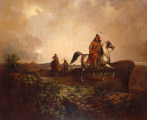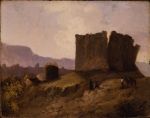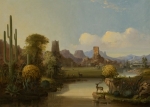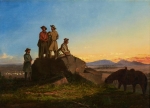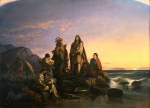More than 150 years after his Smithsonian gallery burned to the ground, John Mix Stanley is receiving a long overdue retrospective exhibition. Considered the premier painter of the American West and a prolific artist, Stanley traveled thousands of miles crisscrossing the western territories and the kingdom of Hawaii in the mid-19th century, painting portraits of Indians for his North American Indian Gallery.
Painted Journeys: The Art of John Mix Stanley opens Oct. 3, 2015 at Gilcrease Museum and runs through Jan. 3, 2016. This groundbreaking exhibition will feature 60 key works from his oeuvre depicting portraits and painted scenes from his encounters with American Indians and expeditionary figures on his numerous journeys west.
“In his day, Stanley was viewed as the premier painter of Native Americans,” says Peter H. Hassrick, senior scholar and director emeritus at the Buffalo Bill Center of the West in Cody, Wyoming.
“His motivation was to give the Native Americans a face as the subjects of fine art, unlike George Catlin and Karl Bodmer who were driven by science and the desire to record the moment. Without him, we would be hard pressed to find fine art images of Native Americans that span the entirety of the western United States. John Mix Stanley was one of the most traveled artists of his time. His adventuresome spirit and his quest to be exposed to the broadest possible spectrum of the western scene are quite fascinating. This exhibition provides a rare opportunity to look more closely at this complex artist and chart, through the course of his western journeys, his progress in achieving this desire,” said Hassrick.
Stanley (1814–1872) was working during a contentious time of competing regional interests and a burgeoning national desire for westward expansion that ultimately wound its way through several major wars. He grew up on the western boundary of Troy, New York, and soon began his career as an itinerant portrait painter in Detroit. His initial travels through the Old Northwest provided him the impetus to build and create an Indian Gallery of portraits and scenes of Native people and their life ways in order to preserve and enrich their legacy.
Over the course of 15 years, Stanley continued to find opportunities to head west — from traveling the Santa Fe Trail and joining up with General Stephen Kearny’s Army of the West’s march towards California, to wandering between Oregon and Washington Territory as a member of Isaac Stevens’ Pacific Railroad survey expedition. He even sailed as far west as Hawaii, which proffered the opportunity to paint the portraits of the then King and Queen.
In 1852, he deposited his Indian Gallery of more than 200 works for display in the nation’s capital at the Smithsonian Institution. The gallery was praised for its superior artistic merit and historical value to the nation, remaining there for over a decade until it was nearly totally destroyed in 1865 when the Smithsonian building burned. Only seven paintings were saved. Despite this untold loss, Stanley continued his quest to paint the west and its inhabitants and attempted to rebuild his gallery in various forms.
Taken as a whole, this exhibition highlights Stanley’s vision to bridge the gap between the contrasting American perceptions of the West, both as a static natural paradise and a theater of progress. With his art, Stanley helped moderate the prickly history of the antebellum American West, uniting the forces of civilization and untrammeled nature, and reconciling a receding Native America with one of aggressive Anglo expansion by idealizing both but privileging neither.
The exhibition is organized by the Buffalo Bill Center of the West, Cody, Wyoming.
Following the exhibition at Gilcrease Museum, Painted Journeys will travel to its final destination, the Tacoma Art Museum, Tacoma, Washington (January 30-May 1, 2016).
The exhibition is accompanied by a definitive book, Painted Journeys: The Art of John Mix Stanley, containing biographical and interpretive essays as well as a select catalogue of the artist’s known works. Written by Hassrick, the book includes scholarly essays by Besaw; as well as Lisa Strong, director of the Art and Museum Studies master’s program and associate professor of the practice at Georgetown; Emily C. Burns, assistant professor of art history at Auburn University; and Scott Manning Stevens, associate professor and director of Native American Studies at Syracuse University. Published by Oklahoma University Press, the catalog will be available for purchase in the Gilcrease Museum Store.
Credits
Peter H. Hassrick is director emeritus and senior scholar at Buffalo Bill Center of the West in Cody, Wyoming and director emeritus of the Denver Art Museum’s Petrie Institute of Western American Art. With more than 40 years of experience in the field of western art, Hassrick is a national authority on numerous artists from William Ranney and Alfred Jacob Miller to Ernest Blumenschein and Frederic Remington. Hassrick’s work has helped to elevate western American art scholarship and popular interest. He earned a B.A. degree in History from the University of Colorado and an M.A. degree in Art History from the University of Denver.
Mindy N. Besaw is curator at Crystal Bridges Museum of Art in Bentonville, Arkansas, and the former curator of the Whitney Western Art Museum at Buffalo Bill Center of the West in Cody, Wyoming. Besaw spearheaded the reinstallation of the Whitney in 2009. She has lectured and written on a range of topics related to American Art and the American West — from Charles M. Russell’s wax sculptures to living artists in the American West today. A doctoral candidate at the University of Kansas, she earned her M.A. in Art History at the University of Denver.
